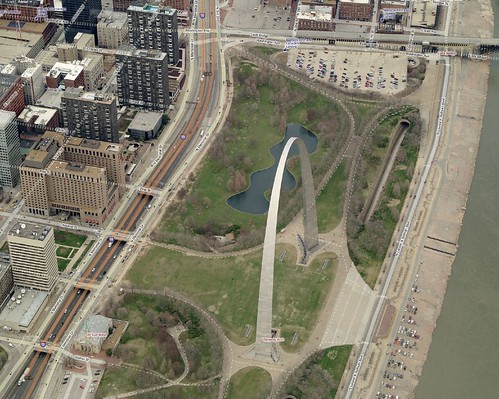The Framing a Modern Masterpiece limited competition has selected 9 teams to redesign the surroundings of the Arch grounds and reconsider ways of "integrating open space into a city’s urban fabric".
Thing is, the problem is not just one of integration, but also of proportion. There's too much "open space" and not enough "urban fabric". This is the basic problem and if it is not directly and boldly addressed, nothing of substance will be accomplished.
Solving that problem requires doing something utterly blasphemous: getting rid of green space, and I mean lots of it. In the Arch's case, that means the gigantic swaths of unused land - including the reflecting ponds that sit to the north and south of the walkways approaching the Arch. These are utter dead zones - uncrossable, unused, unnoticed, and speaking for myself at least, unloved. They are photo opportunities, but not part of the city.

The reflecting pond shown here is ringed by distant walkways. I would be thrilled to see everything inside those walkways filled in, the street grid extended into them, and new buildings in the 2- to 6-story range constructed on them. A curving line of modern facades could front the walkways approaching the Arch, bringing the life of the city and the destination power of the Arch together, framing the Arch as part of the city rather than an abstract and distant sculpture. Hold the buildings back a few feet, enough to preserve the line of trees on the north and south walkways, include retail and restaurants and living space, and you've created a streetscape as lovely as any in the city, while answering the inevitable question of tourists walking out after visiting the top of the Arch: okay, what do we do now?
I would urge the competition teams not to get lost in grand visions of cutting-edge design philosophies, abstract notions, and isolated instances of avant guard design. St. Louis is a gridded 19th Century American city. This is a simple, basic concept that has worked for two hundred years, and it is what will work best here, too. The entire problem is that the grid was violated, desecrated, and ignored. This is not a new problem, requiring radical and untried visionary solutions; it has been confronted and solved many, many times in recent decades.
The mission is to bring the city and the Arch grounds together. This is not an abstract or philosophical mission. There is no reason not to be quite literal about it - in fact, anything else will result in failure. The Arch isn't going anywhere, so bring the city to the Arch.
The Arch grounds stole away forty square blocks of downtown St. Louis. It's time to give some of it back.

